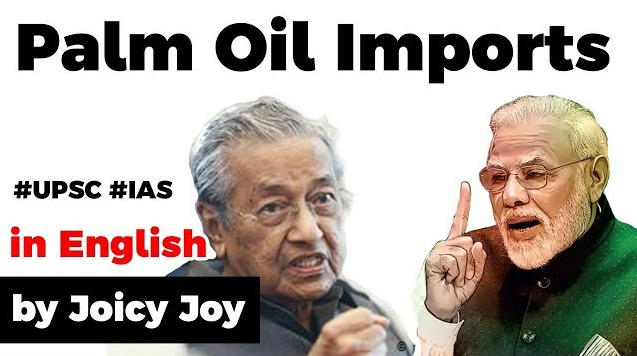Table of Contents
CURRENT AFFAIR
- India has cut import duty on crude palm oil (CPO) and refined, bleached and deodorised (RBD) palm oil.
- It also moved RBD oil from the “free” to the “restricted” list of imports.
How much palm oil does India import?
- India imported 64.15 lakh metric tonnes (MT) of CPO and 23.9 lakh MT of RBD in 2018-19, the bulk of which was from Indonesia.
- The official data show India imported $10 billion worth of vegetable oil in 2019-20, making it the country’s fifth most valuable import.
Why does India need so much palm oil?
- It is the cheapest edible oil available naturally and its inert taste makes it suitable for use in range of foods.
- It stays relatively stable at high temperatures, and is therefore suitable for reuse and deep frying.
- It is the main ingredient in vanaspati (hydrogenated vegetable oil).
IMPACT ON FOOD INFLATION
- It is unlikely that restricting the refined palm oil imports will impact food inflation immediately, as palm oil is not used in Indian homes and also CPO continues to be imported.
Why India has restricted import of Malaysian palm oil?
- The move has been construed as retaliation against Malaysian Prime Minister who has criticised India’s internal policy decisions.
- Since 2017, Malaysia has also been sheltering the Islamic preacher Zakir Naik, who is wanted by India on charges of money laundering, hate speech, and links to
OTHER COUNTRIES
- The import of RBD palm oil has been restricted (not banned) from all countries, not just Malaysia. CPO can still be imported freely.
WHAT WILL HAPPEN NOW?
- Under the trade classification system that India follows, all goods whose import is not restricted or prohibited are traded freely.
- Normally, a special licence is required to import a restricted good.
- The government has neither specified what the restrictions entail nor issued any licences for the import of the restricted RBD.
Who will be impacted by the decision?
- Indonesia and Malaysia together produce 85% of the world’s palm oil, and India is among the biggest
- Both Indonesia and Malaysia produce refined palm oil.
- However, Malaysia’s refining capacity equals its production capacity – this is why Malaysia is keen on exporting refined oil.
- Indonesia can supply CPO which would allow India to utilise its full refining capacity.
REFINING
- The entire refining process increases the price of a barrel of crude oil by about 4%.
- Additionally, there are costs to transporting the crude, which makes it more cost-effective to import the refined oil.
DEMAND OF REFINING INDUSTRY
- The refining industry has been demanding that the import duty on refined oil be increased, which would make importing crude oil cheaper than importing refined oil.
IMPACT ON FARMERS
- Restricting refined oil imports will not help farmers directly, as they are not involved in the process of refining.
- However, the restrictions have caused refined palm oil prices to increase.
- If prices continue to hold, farmers will get a better realization for their crop.
- But the timeframe over which the changes in import policy will have an effect on domestic crop realization is fairly long, given that palm trees take over 4 years to provide a
- Also, if the demand is met entirely by importing and refining CPO, farmers will be left out of the picture.
How will Malaysia be affected?
- Malaysia has said that it cannot retaliate against India because it is too small.
- With imports to India, its largest market restricted, Malaysian palm oil futures fell.
- In 2018, Malaysia exported 25.8% of its palm oil to
- If India does not issue licenses for importing refined oil, Malaysia will have to find new buyers for its
AGREEMENT
- India and Malaysia signed a free trade agreement in 2011, Malaysia-India Comprehensive Economic Cooperation Agreement.
- Under the agreement, India was required to reduce import duty on CPO to 37.5% (from 40%) by December 2019, and on RBD to 45% (from 54%) by December, 2018.
Latest Burning Issues | Free PDF






















 WhatsApp
WhatsApp